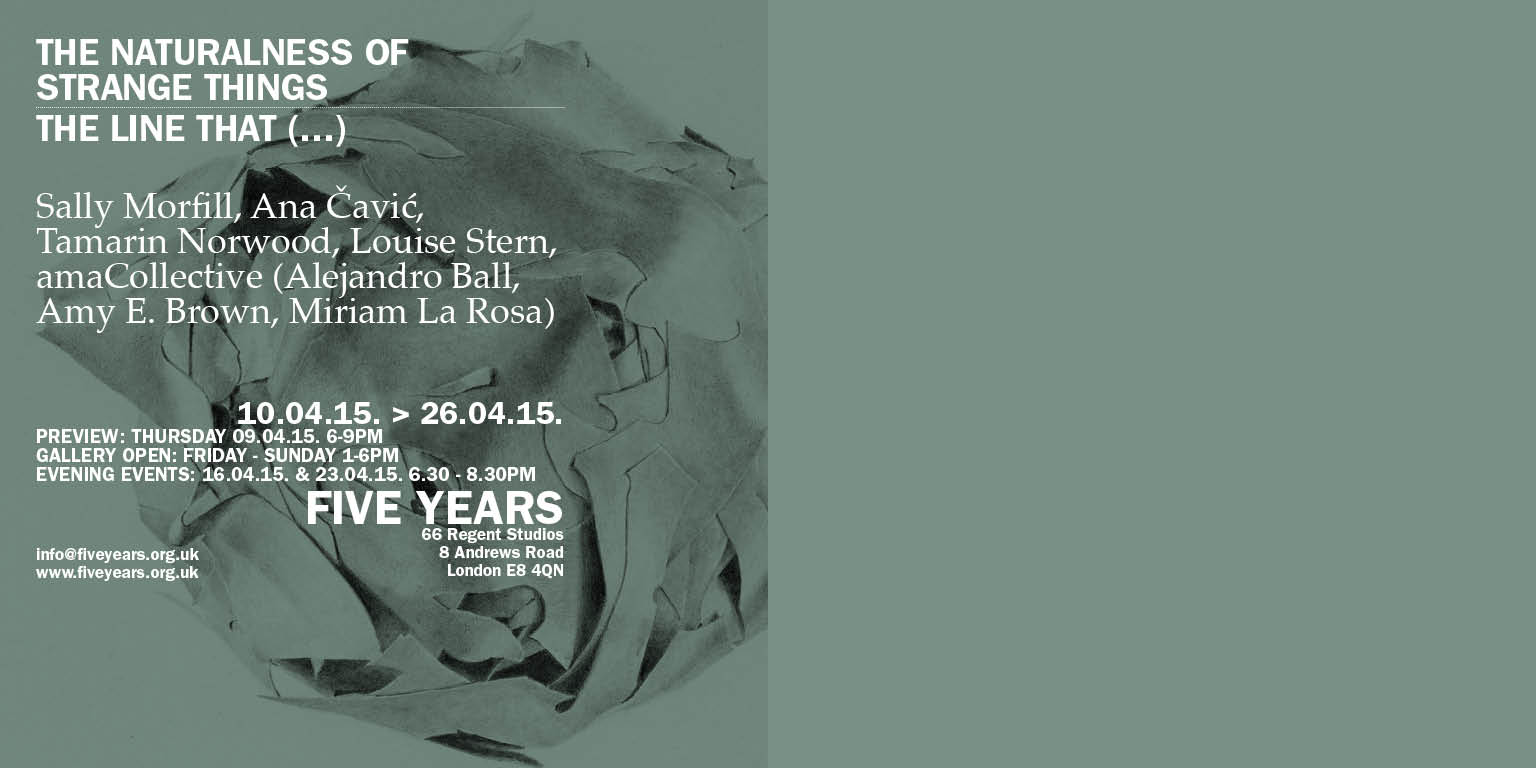
the line that (…)
9 April 2015 6-9pm:
the line that (draws): Sally Morfill and Ana Čavić
16 April 2015 6.30-8.30pm:
the line that (breathes): Tamarin Norwood, Sally Morfill & Ana Čavić
23 April 2015 6.30-8.30pm:
the line that (speaks): Louise Stern, Tamarin Norwood, Sally Morfill and Ana Čavić
The Naturalness of Strange Things
the line that (draws)
Sally Morfill and Ana Čavić
The aim of Henri Michaux’s early graphic work was ‘to reconcile writing and drawing, which after all are both attributes of the same line’.[1] Sally Morfill and Ana Čavić have each responded specifically to a group of lines from his drawing Alphabet (1927). The initial (mis)translation of Michaux’s lines comes from Morfill’s attempts at redrawing; efforts to capture unfamiliar graphic marks with the speed and rhythmic fluidity of handwriting. Sets of this same group of redrawn lines, cut from vinyl sheets, provide a material kit for both artists to work with. After removing the surplus vinyl, turning the leftovers first into small-scale sculptures and finally returning to drawing, Morfill passed the remaining vinyl lines on to Čavić who constructed them, piece by piece, into a series of poems.
Both Morfill and Čavić have revisited and revised their conversation with Henri Michaux’s Alphabet drawing, almost language, on five separate occasions to produce a series of propositions from the same starting point. Each of Morfill’s drawings is an accumulation of carefully rendered shapes. The waste adhesive vinyl remnants, layered and wrapped to make the sculptures, were copied piece by piece, both amplifying and slowing down the quick gestures that initiated the project. Each of Čavić’s poems is a formation of meaningful, albeit tangled, writings out of the same set of meaningless (in the sense that they cannot be read and understood as language) fragments of drawing. In their undoing - as the careful reader unpicks their legible forms and gleans meanings - the fluid poems revert back and forth between sculpture and concrete poetry, evading and sometimes defying any definition of reading.
The drawings and poems from The Naturalness of Strange Things will form part of the content of a forthcoming publication from Everyday Press alongside drawings by SE Barnet and an essay by Louisa Minkin.
In his treatise Elements, Euclid defines a line as a ‘breadthless length... which lies evenly with the points on itself’.[2] This idea of a circuitous, infinite connection, inclusion and enclosing, is the basis for an exhibition programme, in which Sally Morfill and Ana Čavić, Tamarin Norwood and Louise Stern are points on a line that lengthens and reshapes over the three weeks of the show. In this exhibition, straight lines collapse, reconfigure and acquire breadth through the individual artists’ respective approaches to translation.
amaCollective have curated a series of interventions for The Naturalness of Strange Things. The reactive programme, the line that (...), will feature invited artists Tamarin Norwood and Louise Stern, whose interjected works over two consecutive Thursdays will expand and extend upon the notions of dialogue, translation and loss.
the line that (breathes)
From April the 16th, Tamarin Norwood’s piece A Line Describing a Curve Describing a Curve (2015) will become part of the exhibition. The remnant of a pre-existing work, the film shows an object recovering and breathing, regaining form to rest as an altered version of its original self. It is the physical representation of something that, through a translation process, has changed in a fundamental way while still respecting the form, or perpetual line, of dialogue. A Line Describing will be accompanied by a new text, alluding to the notion of the line as a link, whether it is written, drawn or spoken. By addressing the concept of leftovers in a conversation, those that have been part of an artwork, part of a dialogue and part of a collaboration, the work expands upon the permanence of line and breath as part of something continually present. In combination with the works already in the space, Tamarin Norwood’s piece will encourage a different interpretation of loss, as a transformative element rather than a diminishing one. Ultimately resulting in a connection with the words of Ana Čavić, whose poems flit between that of writing and drawing, and Sally Morfill’s drawings that are material renderings of the leftover parts of dialogue.
the line that (speaks)
From April the 23rd, Louise Stern’s piece Extractions will become part of the exhibition, encouraging consideration of the nuances of speaking and conversation. By stitching together the monologues of different men, the concept of conversation is created. In the film, there is an uncanny feeling of something being missed, with attention drawn to facial movements. The distinct absence of elements of an average exchange begins to take form as the rhythmic piece is watched. The piece converses with that of the breathing in Tamarin Norwood’s addition and oppose the idea of dialogue as one circuitous line. Through these conversations of extracted material, things like pause, breath and movement become more present. The particular losses in the film converse directly with the other pieces in the show, making the audience aware of the intangible through the tangible.
- Jenny, L. (2000) ‘Simple Gestures.’ In de Zegher, C. (ed.) Untitled Passages By Henri Michaux. London, New York: Merrell Publishers Ltd, The Drawing Center, pp. 187-198.
- Faber, R.L. (1983) Foundations of Euclidean and Non-Euclidean Geometry. New York: Marcel Dekker, Appendix A.p. 291